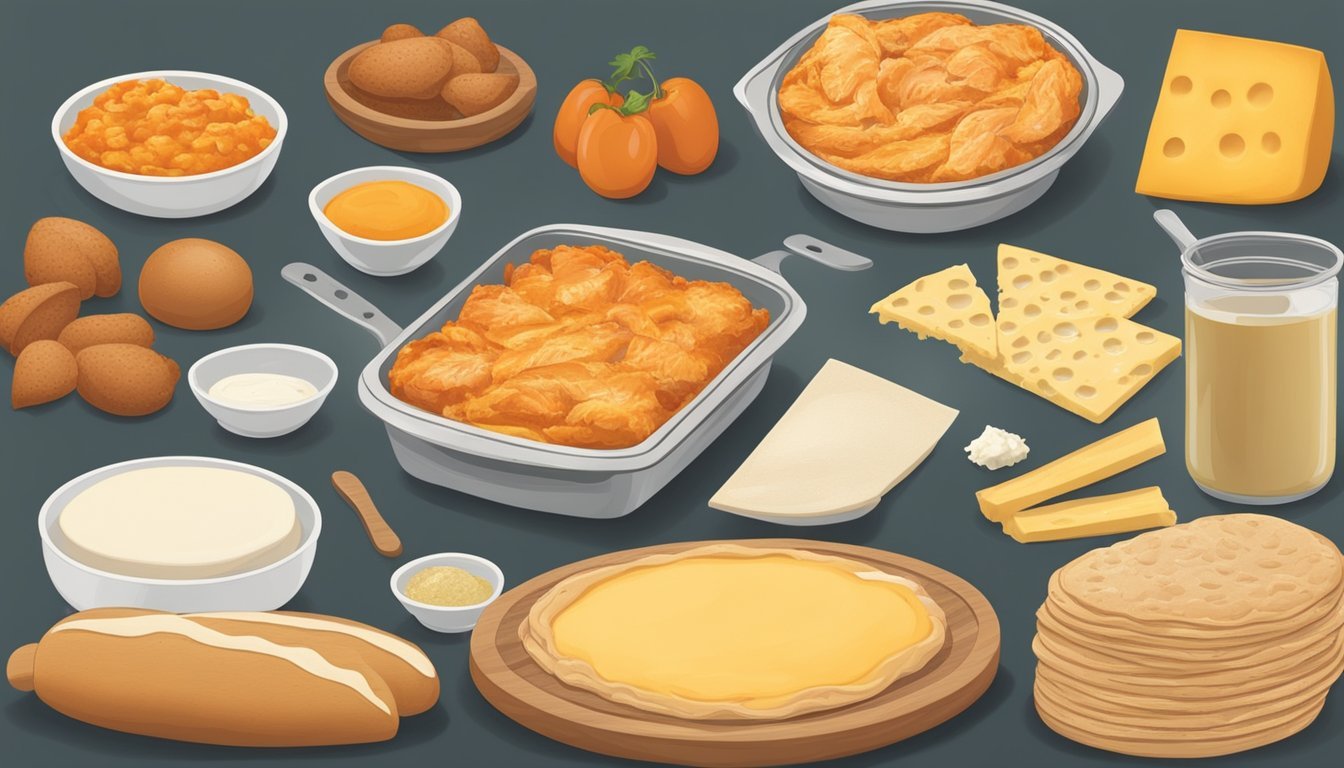Is Buffalo Chicken Pizza Vegan?
Unpacking Dietary Facts
Buffalo chicken pizza (What wine goes well with pizza?) traditionally features spicy buffalo sauce, chicken, cheese, and often a drizzle of creamy dressing. As such, it would not be suitable for vegans, who abstain from all animal products. However, the culinary landscape has evolved to include a plethora of plant-based options, paving the way for vegan buffalo chicken pizza. This version substitutes the animal-based ingredients with plant-based cheeses, vegan chicken alternatives, and dairy-free dressings.
The key to creating a delicious vegan buffalo chicken pizza lies in replicating the textures and flavors that the classic version offers. Vegan chefs and food companies have developed creative ways to achieve the characteristic mouthfeel and taste, utilizing ingredients like soy, wheat gluten, and a variety of plant-based milks and oils. Spices and seasoning play a critical role, as they bring the iconic buffalo sauce heat to the mix, making the pizza appealing not just to vegans, but to anyone looking to explore meat-free options.
Restaurants, recipe blogs, and frozen food brands have all contributed to the rising popularity of vegan buffalo chicken pizza. By employing culinary innovations such as cashew cream for richness and seitan (What wine goes well with seitan?) for a chewy, protein-packed bite, these creations cater to the demand for vegan comfort food. The result is a pizza that delivers on the promise of indulgence without compromising on ethical and dietary preferences.
Understanding Veganism
Veganism is a dietary and lifestyle choice that excludes all animal products and by-products. This commitment impacts food consumption, clothing, and other aspects of life.
Defining 'Vegan'
The term 'vegan' refers to a person who does not eat or use animal products. Unlike vegetarians who may still consume dairy or eggs, vegans strictly avoid these, adhering to a plant-based diet. In the context of food, this means a vegan will not consume meat, dairy, eggs, or any product derived from animals.
Common Vegan Substitutes
To replace common animal-based foods, vegans use a variety of plant-based substitutes. Here are specific alternatives a vegan might use in their diet:
Dairy Milk:
Cheese:
Vegan cheeses are often made from nuts (like cashews), soy, or root vegetables, with nutritional yeast added for a cheesy flavor.
Butter:
Vegan butter substitutes are usually made from a blend of oils and may include soy, almond, or vegetable oils.
In recipes such as buffalo chicken pizza, where dairy cheese would typically be used, plant-based alternatives like vegan mozzarella shreds are a suitable vegan option. These substitutes aim to mimic the taste and texture of their dairy counterparts while aligning with vegan principles.
Buffalo Chicken Pizza Ingredients
Buffalo chicken pizza merges the zest of buffalo sauce with the heartiness of chicken on a classic pizza base. The choice of ingredients significantly influences whether the dish is vegan.
Traditional Ingredients
Buffalo Sauce: A tangy sauce typically made with a base of hot sauce combined with melted butter and seasonings like garlic powder.
Cheese: Shredded mozzarella is the usual choice, offering a creamy, melty topping.
Pizza Dough: A blend of flour, water, yeast, and salt, hand-tossed for that classic pizza base.
Chicken: Often includes either chunks or shreds of cooked chicken breast coated in buffalo sauce.
Vegan Ingredient Alternatives
Vegan Buffalo Sauce: Made with hot sauce and vegan butter or oil alternatives. Seasonings remain similar to the traditional counterpart.
Vegan Mozzarella: Plant-based cheese options made from ingredients like cashews, coconut oil, or tapioca, designed to replicate the melt and stretch of dairy cheese.
Pizza Dough: Vegan pizza dough is available, made without animal products such as dairy or eggs.
Vegan Chicken: Plant-based chicken, such as seitan or soy curls, mimics the texture of chicken after being seasoned and sautéed.
Vegan Pizza Dough
creating the perfect vegan pizza dough involves selecting the right ingredients and mastering a few essential techniques. This process ensures a base that is both tasty and compliant with a vegan diet.
Ideal Dough Composition
A standard vegan pizza dough contains four main components: flour, water, yeast, and salt. The flour should ideally be high in protein, such as bread flour, to give the dough structure and chewiness. Yeast acts as a leavening agent, and it must be activated with warm water to work effectively. The salt is crucial for flavor and controlling the yeast's rate of fermentation. Some recipes include a small amount of sugar to help the yeast thrive, and olive oil can be added to the dough to enhance its flavor and texture.
Table: Vegan Pizza Dough Ingredient Proportions
Ingredient Quantity for Basic Dough Flour 2-3 cups Warm Water 1-1 1/4 cups Yeast 1 teaspoon Salt 1 teaspoon Sugar 1/2 teaspoon (optional) Olive Oil 1-2 tablespoons (optional)
Homemade Vegan Pizza Dough Tips
When preparing homemade pizza dough, temperature plays a key role; the water used should be warm but not too hot to touch—ideally between 110-115°F—to properly activate the yeast. A mixture that is too hot may kill the yeast, while too cold can delay the dough's rise. One should allow the yeast to bloom in the water for about 5-10 minutes; it should look foamy, indicating that it's ready.
To mix the dough, thoroughly combine the dry ingredients before adding the yeast mixture and olive oil. If using a stand mixer, a dough hook attachment will best mimic the kneading process. When kneading by hand, one should aim for a smooth and elastic dough, which often takes about 10 minutes. After kneading, the dough should rest in a warm place until it doubles in size.
List: Steps to Knead and Proof Dough
Combine dry ingredients—flour, salt, and if used, sugar.
Add activated yeast to the dry mixture along with olive oil.
Knead until smooth and elastic.
Let the dough rise in a warm environment until it doubles in size.
To ensure consistency and avoid common pitfalls, use a scale to measure ingredients rather than volume measurements, and consider environmental factors like humidity and altitude that may affect the dough.
Vegan Cheeses and Substitutes
In creating vegan versions of buffalo chicken pizza, the cheese is pivotal. Vegan cheeses come in various forms, often designed to mimic the melting qualities of dairy-based mozzarella.
Vegan Mozzarella Options
Vegan mozzarella is typically derived from plant-based ingredients such as almond milk, coconut oil, cashew nuts, or even starches. These options provide the stretchy, melting quality desired on pizza. For instance:
Commercial Vegan Mozzarella: Brands often use a combination of oils and plant-based proteins to achieve a melt-worthy consistency, resembling dairy mozzarella's texture.
Homemade Vegan Mozzarella: It usually involves blending cashew nuts for richness, nutritional yeast for a cheesy flavor, and agar for gelatinous binding.
Nutritional Comparison
When comparing vegan mozzarella to its dairy counterpart, several nutritional aspects come to light:
Nutrient Vegan Mozzarella Dairy Mozzarella Calories Typically lower Higher due to animal fats Fat Content Varies; often lower in saturated fats Higher in saturated fats Protein Lower; dependent on base ingredient Higher; contains animal protein Vitamin B12 May be fortified with B12 Naturally present in dairy Calcium May be lower unless fortified Naturally high in calcium
Vegan cheeses often add nutritional yeast to impart a savory, cheese-like flavor while providing additional nutrients like B-vitamins. Some consumers opt for vegan cheeses for dietary restrictions, ethical reasons, or health concerns associated with dairy.
Buffalo Sauce and Vegan Variations
Buffalo sauce typically contains ingredients such as hot sauce and butter, posing a challenge for vegans seeking the same tangy flavor profile. This section explores the composition of buffalo sauce and how it can be adapted to fit a vegan diet.
What Makes Buffalo Sauce
Buffalo sauce's characteristic kick comes from cayenne pepper, which is the primary ingredient in most hot sauces used in its preparation. Traditional buffalo sauce is a mixture of this hot sauce with butter, giving it a rich, tangy, and spicy flavor. Additional seasonings such as garlic powder, salt, and sometimes paprika enhance the complexity of the sauce.
Vegan Buffalo Sauce Replacements
When crafting a vegan buffalo sauce, the key is to replace the butter without losing the smoothness it imparts. Vegan buffalo sauce often uses plant-based alternatives, such as:
Cashew cream: A popular choice, which provides a creamy texture and mild flavor that doesn't overpower the cayenne and garlic.
Oil: Some recipes use oils like olive or canola to emulsify the sauce, though this results in a lighter texture.
To retain the original taste, vegan chefs ensure that the heat element, sourced from cayenne pepper based hot sauce, remains prominent while the buttery richness is mimicked through these vegan substitutions.
Creating the Vegan Buffalo Chicken
When making vegan buffalo chicken for pizza, the focus is on selecting the right plant-based chicken substitute and seasoning it to closely mimic the spicy and tangy flavors associated with buffalo chicken. The final product should offer a satisfying texture and rich flavor that complements the other pizza toppings. (What wine goes well with pizza toppings?)
Plant-Based Chicken Substitutes
Vegan buffalo chicken can be crafted using various plant-based ingredients, each with its own unique texture and protein content. Popular options include:
Tofu: A versatile soy-based protein that absorbs flavors well. It should be pressed and crumbled for a texture that resembles shredded chicken.
Seitan: Made from wheat gluten, seitan has a chewy, meat-like texture. Browned and cut into strips or shreds, it serves as an excellent base for the buffalo flavor.
Cauliflower: While not high in protein, cauliflower florets offer a hearty bite and are ideal for those seeking a whole-foods option.
Commercial Plant-Based Chicken: Pre-made vegan chicken products provide a convenient and often high-protein alternative that closely mimics chicken's texture.
Preparing and Flavoring
Once the base is selected, the following steps ensure the vegan chicken is optimally flavored:
Browning: For tofu, seitan, or commercial substitutes, sauté in a pan until the pieces are browned around the edges for added depth of flavor.
Seasoning: Incorporate spices like onion powder, garlic powder, paprika, and white pepper to build a complex flavor profile.
Buffalo Sauce: Toss the browned protein in buffalo sauce, ensuring each piece is evenly coated with the sauce for that signature spicy kick.
Assembling and Baking the Pizza
When creating a vegan buffalo chicken pizza, the process of layering ingredients and using the right baking techniques are crucial for achieving a well-balanced flavor and ideal crust texture.
Layering Ingredients for Balance
A vegan buffalo chicken pizza requires careful attention to the distribution of ingredients to maintain balance in every bite. Begin by spreading a layer of vegan buffalo sauce over the pizza crust, ensuring it's even but not overly saturated, to prevent a soggy base. Next, add a layer of vegan chicken substitute, such as seasoned seitan or soy curls, which should be browned and tossed in a little more buffalo sauce for flavor. Following the mock chicken, sprinkle a generous amount of vegan cheese shreds, which will melt and provide a rich, creamy texture. One can add additional toppings like green onion or celery for a fresh crunch.
Crust: Spread with sauce
Vegan Chicken: Evenly distribute browned pieces
Cheese: Generously cover with vegan cheese shreds
Extra Toppings: Optional green onion or celery slices for texture
Baking Techniques for the Perfect Crust
Baking is essential to achieve the characteristic crispy yet chewy pizza crust, with that desirable golden brown finish. Preheat the oven to between 425°F (220°C) and 475°F (246°C). If a pizza stone is available, place it in the oven during preheating to get it hot, which will help in getting a crispy bottom crust. If no pizza stone is present, use a baking sheet or a well-greased pizza pan as an alternative.
The pizza should bake for about 10-15 minutes, but this may vary depending on the oven and the thickness of the crust. Watch for the cheese to become melted and slightly golden, and the crust to crisp up at the edges while remaining chewy inside. If using a pizza oven, the baking time will generally be shorter, so adjustments should be made accordingly.
Oven Temperature: 425°F to 475°F
Pizza Stone: Preheated for crispiness
Baking Sheet/Pan: Alternative if no stone
Baking Time: 10-15 minutes or until crust is golden brown and cheese has melted
Nutrition Profile
Buffalo chicken pizza, particularly in its vegan variant, provides a unique nutrition profile that varies significantly from its traditional counterpart. This section dissects the various nutritional aspects of this plant-based pizza.
Caloric Considerations
The caloric content of a vegan buffalo chicken pizza can vary based on the ingredients used. Typically, the main components include a plant-based chicken substitute, dairy-free cheese, and a buffalo sauce spread atop a vegan pizza crust.
Average Calories: A standard slice (approximately 1/8 of an 18-inch pizza) ranges from 200 to 300 calories.
Sources of Calories: Most calories in this pizza come from carbohydrates in the crust, fats in the cheese alternative, and proteins in the plant-based chicken.
Macros and Micronutrients
Vegan buffalo chicken pizza combines macronutrients from its crust, toppings, and plant-based proteins. Fiber content is usually higher due to whole grain crusts and the presence of vegetables.
Macronutrients:
Carbohydrates: Carbs are primarily derived from the dough and, to a lesser extent, the vegetable toppings. A slice can have between 25 to 40 grams.
Fats: Plant-based cheeses and meat substitutes contain fats. Expect a range of 8 to 15 grams per slice, with a mix of saturated and unsaturated fats.
Proteins: Vegan chicken substitutes are good protein sources, providing about 10 to 20 grams per slice.
Micronutrients:
Fiber: Fiber comes from the crust and vegetables. One slice can provide between 2 to 5 grams.
Sodium: Plant-based toppings and cheese alternatives contain sodium. Levels can range from 300 to 500 mg per slice.
Cholesterol: Vegan pizzas are cholesterol-free as they contain no animal products.
Iron: Fortified crusts and some plant proteins include iron; a slice might contain about 1 to 2 mg.
This nutrition information can help consumers understand the potential dietary impact of adding vegan buffalo chicken pizza to their meal choices.
Serving and Presentation
The visual allure of a dish complements its taste, and serving vegan buffalo chicken pizza is no exception. Presentation is key: vibrant garnishes not only provide eye appeal but also enhance the overall flavor profile.
Garnishes and Toppings
Delicate finesse in choosing garnishes can elevate the presentation of vegan buffalo chicken pizza.
Red Onion: Thinly sliced for a crunchy texture and mild zest
Green Onion: Chopped for a fresh, slightly sharp finish
Vegan Ranch Dressing: Drizzle over the top for a creamy tang
Celery: Diced for a refreshing crunch
Kale or Cilantro: Sprinkle for a burst of color and a hint of earthiness
Buffalo Cauliflower: Small florets add a spicy and hearty element
To assemble, begin with a base of buffalo cauliflower or vegan chicken, layer with vegan cheese, and then arrange the red onions and other toppings to taste. After baking, a generous scattering of green onions, cilantro, or kale can be added for freshness, along with a swirl of vegan ranch dressing for extra creaminess.
Slicing and Serving
Cutting the pizza into even, manageable slices ensures each guest gets an equal taste of all the components.
Allow the pizza to cool slightly after baking, ensuring clean cuts.
Use a sharp pizza cutter or a large knife to slice into the desired number of pieces.
Serve slices on a warm plate or a rustic wooden board for a charming touch.
Served immediately, the vegan buffalo chicken pizza maintains its ideal texture and temperature, allowing guests to savor the balanced harmony of spicy, sweet, and savory with every bite.
Storage and Reheating Tips
When it comes to the storage of buffalo chicken pizza, whether vegan or not, there are straightforward strategies to ensure the pizza maintains its quality.
Storage:
Always refrigerate leftovers within 2 hours of cooking to keep them safe from bacteria growth.
Vegan buffalo chicken pizza should be stored in an airtight container or wrapped tightly with plastic wrap or aluminum foil to preserve moisture.
Properly stored, it can last in the refrigerator for up to 3 days.
Freezing:
If one wishes to keep the pizza longer, freezing is an option.
For best results, freeze individual slices on a baking sheet before transferring them to a freezer-safe bag or container to prevent them from sticking together.
The maximum yield in taste and texture from frozen vegan buffalo chicken pizza is typically one month.
Reheating:
To reheat, it is recommended to use an oven or a toaster oven to retain the crust's crispiness.
Preheat the oven to 375°F (190°C).
Reheating Method Temperature Time Oven/Toaster Oven 375°F (190°C) 10-15 min Microwave (quick fix) High 1-2 min
A microwave may be used for a quick fix, but be mindful it can make the crust soft and chewy.
It is not advisable to leave the pizza at room temperature for an extended period before reheating, as this can compromise both taste and food safety.
When reheating, ensure the pizza is heated through to avoid unevenly warmed leftovers and achieve the ideal taste experience.
Vegan Pizza Variations and Recipes
Vegan pizza offers a rich tapestry of flavors and can be tailored to meet a variety of dietary needs and preferences. By carefully selecting ingredients and employing creative substitutions, one can craft delicious pizzas that are both plant-based and satisfying.
Global Flavors
Italian Classic: A simple Margherita with vegan mozzarella, fresh basil, and a rich tomato sauce can capture the essence of Italy.
Mexican Twist: Spicy vegan buffalo pizza, adorned with vegan cheese, black beans, corn, and avocado, drizzled with vegan ranch dressing.
Mediterranean Delight: A combination of artichokes, Kalamata olives, sun-dried tomatoes, and vegan feta cheese.
Asian Fusion: Topped with teriyaki-glazed tofu, scallions, and sesame seeds over a ginger tomato sauce base.
Dietary Needs and Preferences
Gluten-Free Options: Utilize a gluten-free pizza base made from cauliflower or a blend of rice and tapioca flour.
Cheese Substitutes:
Store-Bought Vegan Cheese: Many varieties, from shreds to slices, can mimic the melt and stretch of traditional cheese.
Homemade Vegan Cheese: Nutritional yeast, nuts, or seeds blended with spices can create a delicious alternative.
Protein Toppings:
Seitan: This wheat protein can be seasoned with buffalo sauce for a vegan buffalo chicken pizza experience.
Tofu or Tempeh: Marinated and baked for a savory bite.
Customizable Toppings: Choose from a myriad of vegetables, including bell peppers, mushrooms, spinach, and onions. For a heartier pizza, add vegan mock meats, seasoned to your preference.
Employing these variations allows individuals to enjoy a diverse selection of vegan pizza flavors that cater to different cultures and dietary considerations, ensuring that pizza night can be a guilt-free indulgence for everyone.
Community Engagement and Feedback
Community engagement and feedback are instrumental in evaluating and enhancing the appeal of vegan buffalo chicken pizza. Through the aggregation of comments and the monitoring of shares on social platforms, brands and chefs can gauge the reception of their recipes.
Comment Sections and Forums
Users frequently turn to comment sections under recipes and forums dedicated to vegan cooking to rate and discuss their experiences with vegan buffalo chicken pizza. Amateur and experienced chefs alike share alterations, comment on efficacy of ingredients, and even troubleshoot common issues. For instance, the incorporation of a vegan buffalo chicken alternative might prompt discussions on the best plant-based substitutes, like seitan or commercially available vegan chicken patties.
Popular Forums:
r/veganrecipes on Reddit
Specialty vegan cooking blogs
Through these platforms, the culinary community rates these recipes, often leading to iterative improvements and the sharing of tips.
Social Media Shares
The visual nature of platforms like Instagram and Pinterest make them ideal for showcasing the final product of a vegan buffalo chicken pizza. Home cooks and professional outlets alike post images and videos, which encourages shares and collective feedback. Individuals often:
Post photos of their creations
Tag the recipe source
Include relevant hashtags (e.g., #VeganPizza, #BuffaloChickenPizza)
These social shares serve as unsolicited peer reviews that can positively influence potential consumers seeking to try the recipe themselves. Through Instagram stories and Pinterest pins, an impactful presence can be established as these platforms operate both as barometers for popularity and hubs for exchange of creativity in vegan culinary arts.











